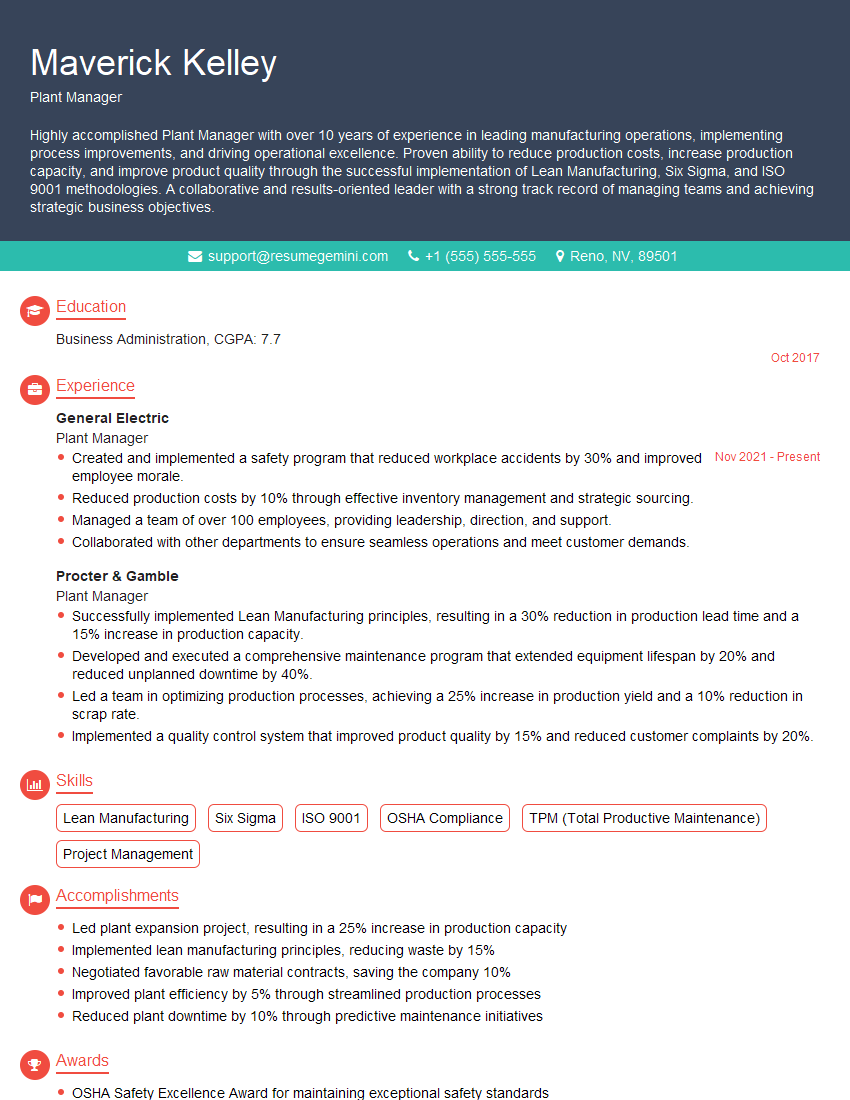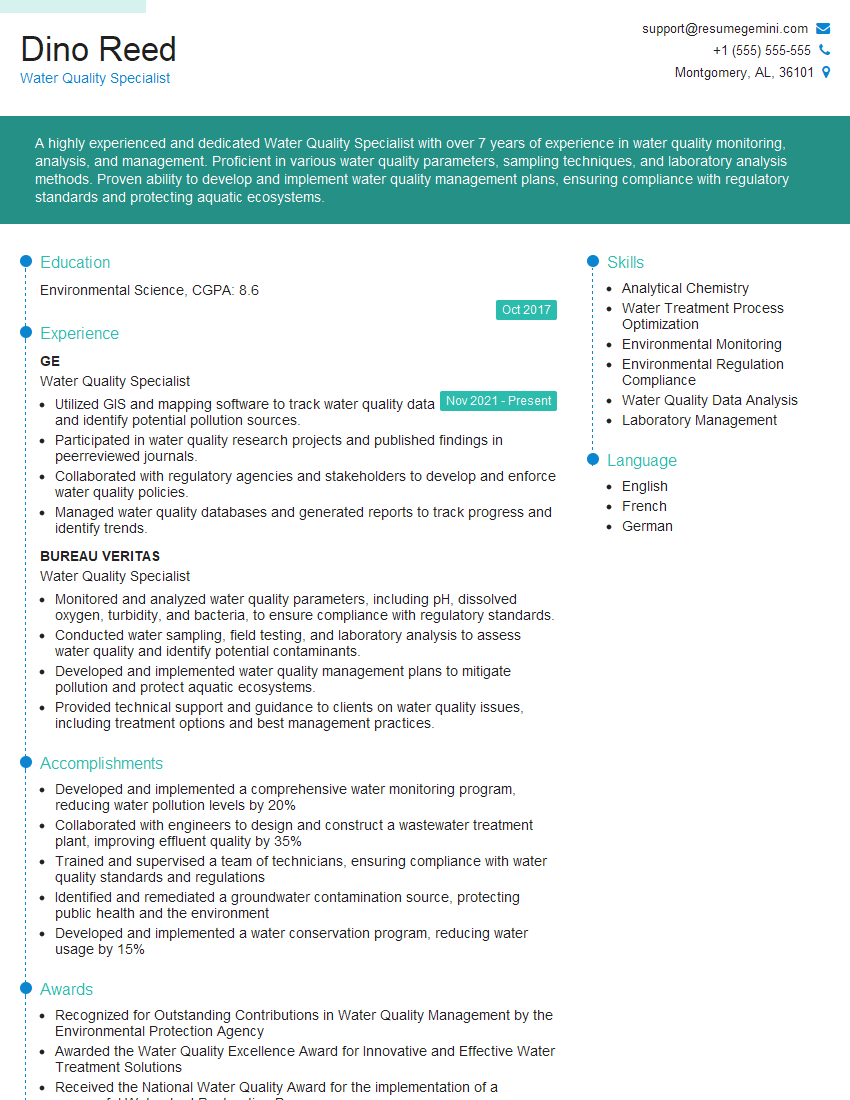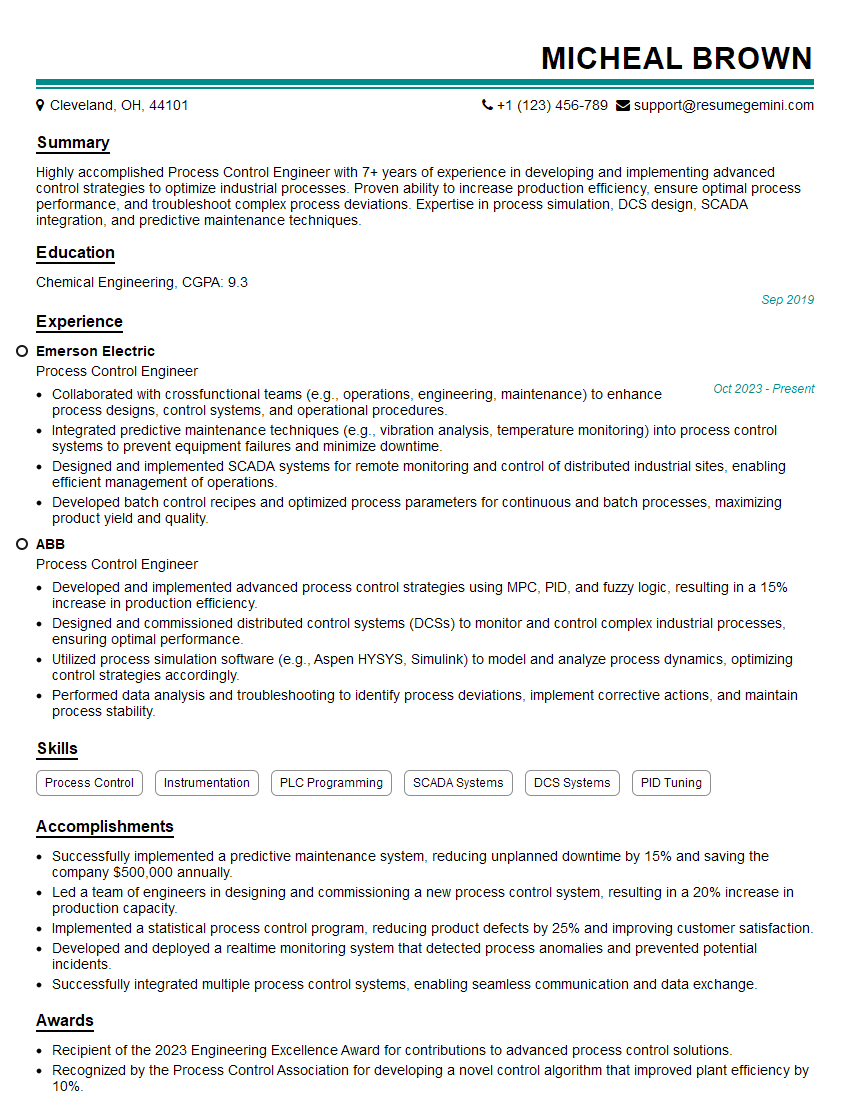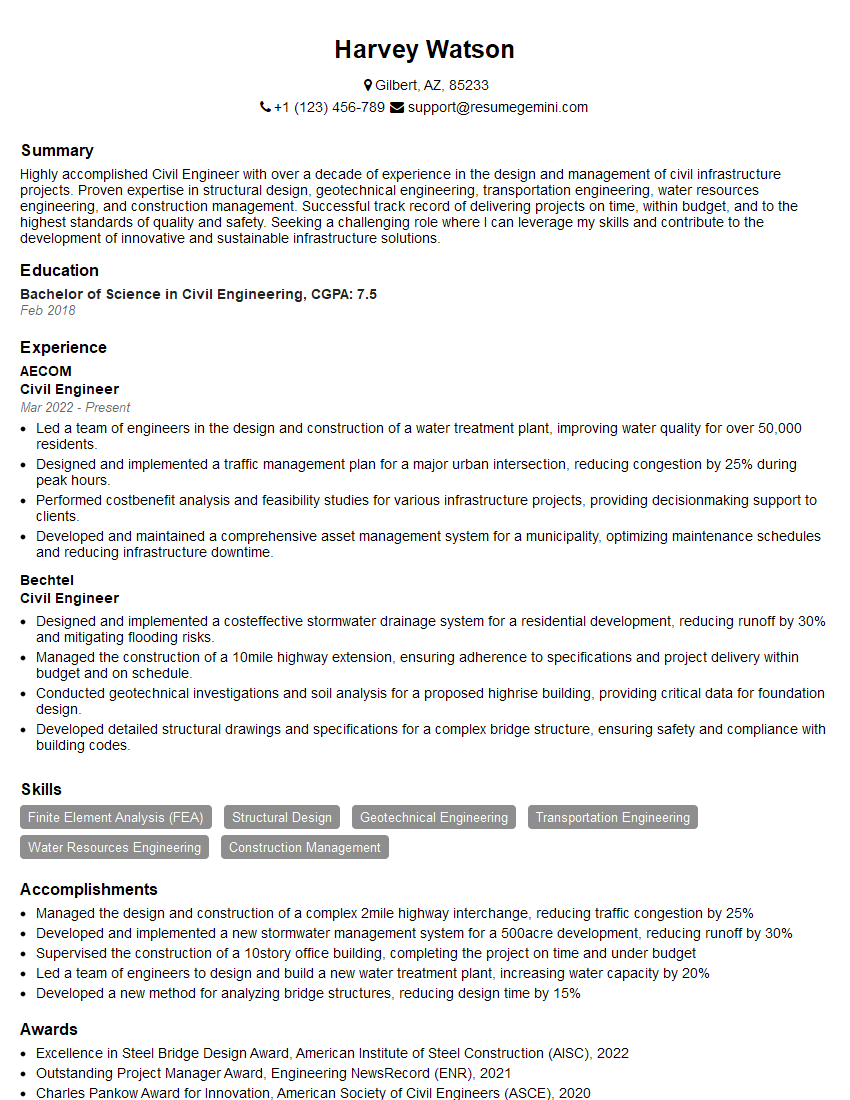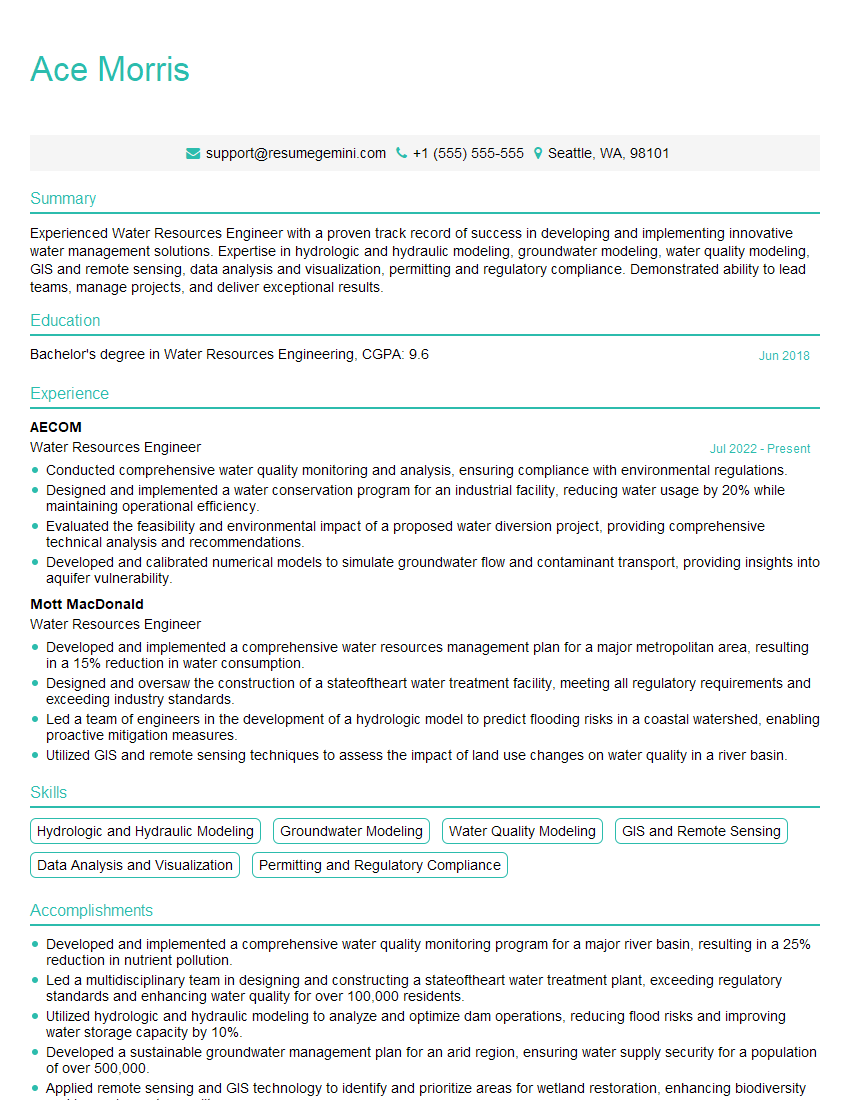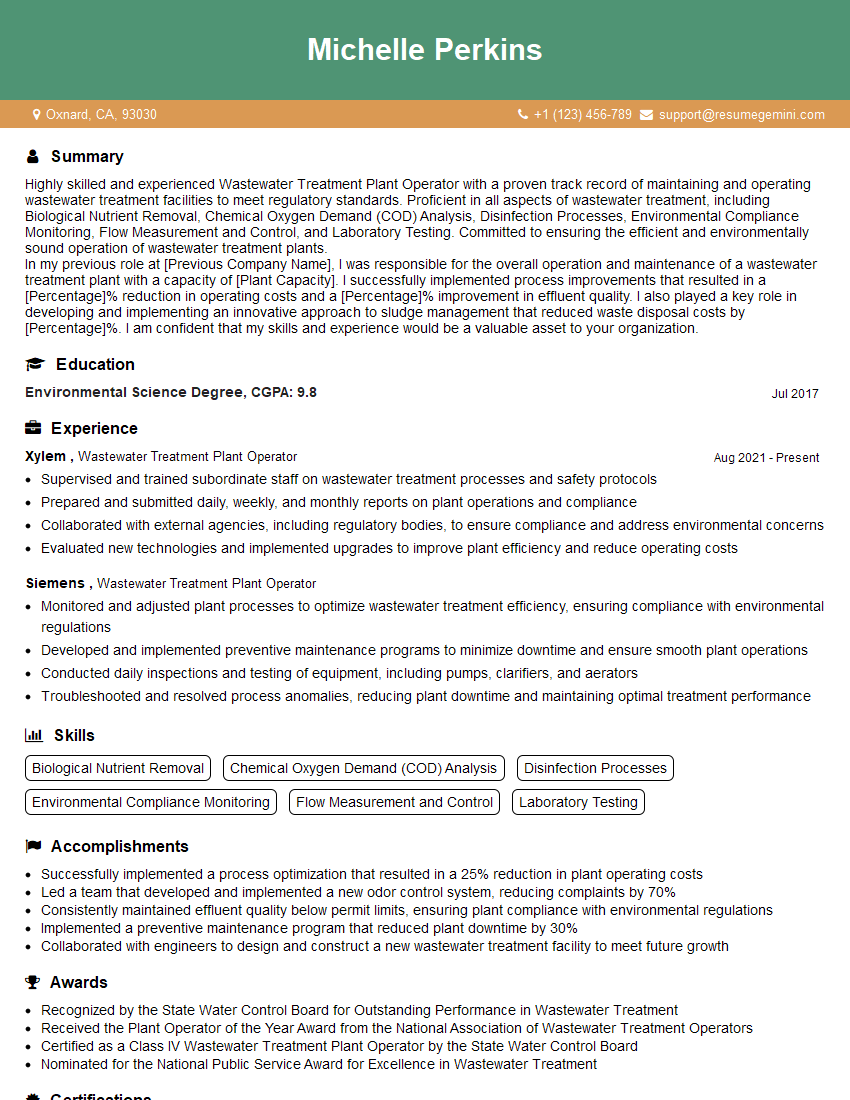The right preparation can turn an interview into an opportunity to showcase your expertise. This guide to Trickling Filter Process interview questions is your ultimate resource, providing key insights and tips to help you ace your responses and stand out as a top candidate.
Questions Asked in Trickling Filter Process Interview
Q 1. Explain the principle of operation of a trickling filter.
A trickling filter is a wastewater treatment process that uses a bed of media to support the growth of a biofilm of microorganisms. Wastewater is distributed over the media, allowing the biofilm to consume organic matter as the wastewater trickles down. Essentially, it’s like a natural biological filter, mimicking the way a stream cleans itself. The microorganisms break down pollutants, converting them into less harmful substances. The treated effluent then collects at the bottom for further processing.
Imagine a large, slowly rotating sprinkler head showering water onto a pile of rocks. The rocks are the media, and the water is the wastewater. As the water trickles down, tiny organisms on the rocks eat up the pollutants, cleaning the water in the process.
Q 2. Describe the different types of trickling filter media.
Trickling filter media comes in various forms, each designed to maximize surface area for microbial growth and efficient wastewater treatment. Common types include:
- Rocks: Naturally occurring stones, historically the most common choice. They offer good durability but can be less consistent in surface area compared to manufactured media.
- Plastic Media: Manufactured media made from various plastics (e.g., PVC, high-density polyethylene). They offer superior surface area and improved flow characteristics, leading to better treatment efficiency and lower head loss. Examples include corrugated plastic sheets, interconnected plastic pieces, and other specially designed shapes.
- Ceramic Media: Made from fired clay, ceramic media offers good strength, resistance to degradation, and a large surface area. They’re often more expensive than plastic media.
The selection of media depends on factors like cost, durability, required treatment efficiency, and available space.
Q 3. What are the advantages and disadvantages of using a trickling filter?
Trickling filters offer several advantages but also have limitations:
Advantages:
- Robust and relatively simple to operate: They require less skilled labor compared to more complex treatment systems.
- Effective at removing BOD (Biological Oxygen Demand) and suspended solids: They significantly reduce organic pollutants in wastewater.
- Can handle shock loads: The large biomass in the filter can buffer against sudden increases in wastewater flow or pollutant concentration.
- Relatively low energy consumption: They don’t require significant energy for mechanical operation.
Disadvantages:
- Large land area requirement: They typically occupy a larger footprint compared to other treatment technologies.
- Susceptible to clogging: Excessive solids buildup in the filter media can reduce efficiency.
- Potential for odor and fly problems: Proper management is needed to prevent these issues.
- Less effective at removing nutrients (nitrogen and phosphorus): Often requires supplemental treatment for nutrient removal.
Q 4. How is the hydraulic loading rate determined for a trickling filter?
The hydraulic loading rate (HLR) is a crucial design parameter in trickling filters, representing the volume of wastewater applied per unit surface area per unit time. It’s typically expressed in gallons per day per square foot (gpd/ft²) or cubic meters per day per square meter (m³/m²/d). The HLR is determined based on several factors:
- Desired treatment efficiency: Higher HLR might result in lower efficiency, requiring larger filters to compensate.
- Type of wastewater: Strength and characteristics of the wastewater affect the filter’s capacity and treatment efficiency.
- Type of media: Different media types have varying surface areas and hydraulic characteristics.
- Recirculation ratio (discussed further below): Recirculation increases the HLR effectively.
Determining the optimal HLR requires careful consideration of these factors and often involves using design equations or empirical data from similar systems. Overloading a filter results in poor treatment efficiency, while underloading is wasteful.
Q 5. What is the significance of the recirculation ratio in a trickling filter?
The recirculation ratio in a trickling filter refers to the ratio of recirculated effluent to the influent flow. It’s expressed as the volume of recirculated effluent divided by the volume of incoming wastewater. For example, a recirculation ratio of 1:1 means that for every gallon of incoming wastewater, one gallon of treated effluent is recirculated back to the top of the filter.
Significance: Recirculation provides several benefits:
- Increased biomass: Recirculation increases the concentration of microorganisms, enhancing the treatment efficiency.
- Improved wastewater distribution: Recirculated effluent helps distribute the incoming wastewater more evenly across the filter media.
- Increased oxygen transfer: The recirculated effluent can introduce more oxygen, which is vital for aerobic microorganisms.
- Buffering against shock loads: Recirculation helps to even out variations in the influent concentration.
However, excessive recirculation can be costly due to increased pumping energy and may lead to other operational challenges.
Q 6. How does the organic loading rate affect the efficiency of a trickling filter?
The organic loading rate (OLR) represents the amount of organic matter applied to the filter per unit volume of media per unit time. It is typically expressed as pounds of BOD per 1000 cubic feet per day (lbs BOD/1000 ft³/d) or kilograms of BOD per cubic meter per day (kg BOD/m³/d).
The OLR significantly affects the filter’s efficiency. A low OLR might result in underutilization of the filter’s capacity, while a high OLR can lead to overloading, resulting in:
- Reduced treatment efficiency: The microorganisms cannot keep up with the organic load, resulting in incomplete treatment.
- Clogging of the media: Excessive organic matter can accumulate, clogging the media and hindering wastewater flow.
- Anaerobic conditions: Oxygen depletion can occur in overloaded areas of the filter, leading to the formation of anaerobic zones and production of undesirable byproducts.
Optimal OLR is critical for efficient and sustainable operation. It’s a balance between sufficient organic matter to support microbial growth and avoiding overloading.
Q 7. Describe the role of microorganisms in the trickling filter process.
Microorganisms are the heart of the trickling filter process. A diverse biofilm of bacteria, fungi, protozoa, and other organisms colonizes the filter media. These microorganisms are responsible for the biodegradation of organic matter in the wastewater.
Role of microorganisms:
- Organic matter decomposition: Bacteria, particularly heterotrophic bacteria, are primarily responsible for oxidizing organic matter (BOD). They use organic compounds as a source of energy and break them down into simpler, less harmful substances (CO2, water, etc.).
- Nutrient transformation: Certain bacteria participate in nitrification (conversion of ammonia to nitrate) and denitrification (conversion of nitrate to nitrogen gas), influencing nutrient removal.
- Solid stabilization: The microorganisms consume suspended solids, helping to settle out solids in the subsequent treatment stages.
- Self-regulation: The microbial community is a self-regulating ecosystem, adapting to changes in wastewater characteristics.
Maintaining a healthy and diverse microbial community is crucial for optimal trickling filter performance. Factors influencing microbial growth include temperature, pH, dissolved oxygen, and nutrient availability.
Q 8. What are the common operational problems encountered in trickling filters?
Trickling filters, while robust, face several operational challenges. Imagine a bustling city – if the infrastructure isn’t maintained, problems arise. Similarly, in a trickling filter, issues can stem from the media, the influent wastewater, or the biological processes themselves.
Clogging of the media: Over time, the filter media (rocks, plastic media, etc.) can become clogged with solids, reducing the surface area available for biofilm growth and hindering wastewater treatment. This is like a clogged drain – the flow slows, and the system becomes less effective. Regular maintenance is key to prevent this.
Ponding: Uneven distribution of wastewater across the filter media can lead to areas becoming waterlogged, creating anaerobic (oxygen-deficient) zones that hinder microbial activity and produce foul odors. Think of it like a poorly watered lawn – some areas are lush, others dry and brown. Proper distributor design and maintenance are crucial.
Filter flies: These insects breed in the moist environment of the filter, causing nuisance problems and potentially indicating operational issues. Their presence suggests a possible imbalance in the system. Control involves managing moisture levels and using appropriate larvicides.
Bulking sludge: An overgrowth of filamentous bacteria can cause the sludge to become bulky and difficult to settle, affecting effluent quality and potentially leading to clogging. This is similar to an overgrown garden – it’s hard to maintain and can become problematic.
Low dissolved oxygen: Inadequate aeration, either due to insufficient air supply or high organic loading, can limit the efficiency of aerobic biological processes. Just as humans need oxygen, the microbes in the filter need it to thrive.
Q 9. How are trickling filters monitored and controlled?
Monitoring and controlling a trickling filter involves a multi-pronged approach. Think of it like regularly checking your car’s vital signs. We need to monitor both the ‘inputs’ and the ‘outputs’, and adjust accordingly.
Influent monitoring: Regular analysis of the wastewater entering the filter includes measuring flow rate, BOD (Biochemical Oxygen Demand), COD (Chemical Oxygen Demand), suspended solids, and pH. This gives a baseline of what needs to be treated.
Effluent monitoring: Regularly analyzing the treated wastewater leaving the filter is crucial to assess its effectiveness. Key parameters include BOD, COD, suspended solids, ammonia, and nitrates. These tell us how effectively the filter is working.
Media inspection: Visual inspections to check for clogging, ponding, or excessive growth are critical. This is similar to checking a building for structural problems.
Dissolved oxygen measurement: Measuring the dissolved oxygen levels within the filter ensures adequate aerobic conditions for microbial activity. Low oxygen indicates a potential problem needing attention.
Control measures: Based on monitoring data, adjustments can be made to the flow rate, recirculation rate, or addition of supplemental oxygen if necessary. This is corrective action, addressing any imbalances found.
Q 10. What are the methods used to clean or maintain trickling filter media?
Cleaning and maintaining the trickling filter media is essential to ensure long-term operational efficiency. Methods vary depending on the type of media and the extent of clogging.
Washing: For less severe clogging, high-pressure water washing can dislodge accumulated solids. This is like power washing a patio – it removes loose debris.
Chemical cleaning: In some cases, chemical treatments may be necessary to remove stubborn organic matter or biofilm. This requires careful consideration to avoid harming the beneficial microbial communities.
Mechanical cleaning: For severely clogged media, mechanical cleaning methods, such as using specialized equipment to remove solids, may be employed. This would be a more intensive ‘deep clean’.
Media replacement: In extreme cases, particularly with older or severely damaged media, complete or partial replacement may be necessary. It is analogous to replacing worn-out parts of a machine.
Regular maintenance schedule: The best method is preventative maintenance—regular inspections and cleaning help avoid severe clogging and extend the media’s lifespan. This is analogous to regular car servicing.
Q 11. Explain the concept of nitrification and denitrification in a trickling filter.
Nitrification and denitrification are crucial biological processes within a trickling filter that contribute to nitrogen removal from wastewater. Imagine them as two stages of a refining process.
Nitrification: This is an aerobic process (requires oxygen) carried out by autotrophic bacteria. Ammonia (NH3) is converted to nitrite (NO2–) and then to nitrate (NO3–). Think of it as breaking down a complex substance into simpler ones.
Denitrification: This is an anaerobic process (occurs in the absence of oxygen) where nitrate is reduced to nitrogen gas (N2), which is then released into the atmosphere. This is like removing a specific element from a mixture.
Combined Process: In a well-functioning trickling filter, both processes occur, leading to significant reductions in nitrogen levels in the effluent. Proper oxygen management is key for a balanced system.
Q 12. How does temperature affect the efficiency of a trickling filter?
Temperature significantly impacts the efficiency of a trickling filter. Think of it like plant growth – temperature affects the rate of growth and activity.
Optimal Temperature Range: The microorganisms responsible for wastewater treatment in the trickling filter have an optimal temperature range. Within this range, their metabolic activity is at its peak. Deviation from this range can slow down or even stop the biological processes.
Temperature Effects: Lower temperatures slow down microbial activity, reducing the treatment efficiency. Higher temperatures, beyond the optimal range, can inhibit microbial growth and even kill them.
Seasonal Variations: Seasonal temperature changes can influence the performance of the trickling filter, resulting in variations in effluent quality throughout the year. Winter months may see lower removal rates.
Q 13. Describe the effect of pH on the biological processes in a trickling filter.
pH plays a vital role in the biological processes within a trickling filter. It’s like the soil’s pH affecting plant growth. An optimal range is needed for microbial life to thrive.
Optimal pH Range: Most wastewater treatment processes, including those occurring in trickling filters, function optimally within a slightly alkaline pH range (approximately 6.5 to 8.5). Outside this range, microbial activity and hence, treatment efficiency are impacted.
pH Effects: Low pH (acidic conditions) can inhibit nitrification, the process of converting ammonia to nitrates. High pH (alkaline conditions) can also inhibit certain microbial processes and lead to poor settling of the sludge.
pH Control: In cases where the influent wastewater has an extreme pH, adjustments may be needed. This might involve chemical additions to buffer the pH and maintain it within the optimal range for efficient treatment.
Q 14. What are the different types of effluent quality parameters monitored in a trickling filter system?
Several effluent quality parameters are monitored in a trickling filter system to evaluate its effectiveness and compliance with regulatory standards. It’s like a comprehensive health check-up for the treated water.
BOD (Biochemical Oxygen Demand): A measure of the oxygen required by microorganisms to decompose organic matter. Low BOD indicates effective treatment.
COD (Chemical Oxygen Demand): A measure of the total oxygen-demanding substances in the wastewater. A similar measure to BOD, but includes non-biodegradable materials.
Suspended Solids (SS): The amount of solid particles remaining in the treated wastewater. Low SS indicates efficient removal of solids.
Ammonia (NH3): A measure of the nitrogen content in the effluent. High ammonia levels indicate incomplete nitrification.
Nitrate (NO3–): A measure of the nitrogen converted during nitrification. Nitrate is a less harmful form of nitrogen, but its concentration needs to be monitored.
pH: The acidity or alkalinity of the effluent. Needs to be within regulatory limits.
Total Coliforms and E. coli: Indicators of the presence of fecal matter and pathogenic organisms. Their absence is a sign of effective disinfection.
Q 15. How do you calculate the BOD removal efficiency of a trickling filter?
Calculating the BOD (Biochemical Oxygen Demand) removal efficiency of a trickling filter involves comparing the influent BOD concentration to the effluent BOD concentration. Think of it like this: you’re measuring how much ‘pollution’ (BOD) the filter removes from the wastewater.
The formula is straightforward:
BOD Removal Efficiency (%) = [(Influent BOD - Effluent BOD) / Influent BOD] x 100
For example, if the influent BOD is 200 mg/L and the effluent BOD is 20 mg/L, the calculation would be:
BOD Removal Efficiency (%) = [(200 mg/L - 20 mg/L) / 200 mg/L] x 100 = 90%
This means the trickling filter removed 90% of the BOD from the wastewater. Accurate measurements of both influent and effluent BOD are crucial for this calculation. Variations in sampling techniques and laboratory analysis can affect the results, so adhering to standardized protocols is essential.
Career Expert Tips:
- Ace those interviews! Prepare effectively by reviewing the Top 50 Most Common Interview Questions on ResumeGemini.
- Navigate your job search with confidence! Explore a wide range of Career Tips on ResumeGemini. Learn about common challenges and recommendations to overcome them.
- Craft the perfect resume! Master the Art of Resume Writing with ResumeGemini’s guide. Showcase your unique qualifications and achievements effectively.
- Don’t miss out on holiday savings! Build your dream resume with ResumeGemini’s ATS optimized templates.
Q 16. What are the safety considerations when working with a trickling filter system?
Safety around a trickling filter system centers on several key areas. First, the potential for falls is significant. The structures are often elevated, and the surrounding areas can be slippery due to wastewater spills or wet conditions. Appropriate fall protection measures, such as guardrails and safety harnesses, are paramount.
Second, there’s the risk of exposure to pathogens and hazardous materials present in the wastewater. Appropriate personal protective equipment (PPE) is essential, including gloves, eye protection, and possibly respirators depending on the nature of the wastewater. Regular training on safe handling practices and emergency procedures is crucial.
Third, moving machinery, like pumps and sludge removal systems, pose mechanical hazards. Lockout/tagout procedures must be strictly followed before any maintenance or repair work begins. Regular inspections to ensure proper functionality and timely repairs are necessary to minimize these risks.
Finally, the potential for the release of harmful gases, like hydrogen sulfide (H2S), exists, especially in the enclosed spaces within the filter media. Proper ventilation and monitoring systems are necessary to ensure a safe working environment. Workers should be trained on the signs and symptoms of H2S poisoning and emergency response procedures.
Q 17. What are the environmental impacts of trickling filters?
Trickling filters, while effective wastewater treatment systems, do have environmental impacts. One key consideration is the potential for odor emissions. The decomposition of organic matter within the biofilm can produce unpleasant smells, particularly hydrogen sulfide. Proper design, including adequate ventilation and odor control systems, is crucial to minimize these impacts.
Another concern is the potential discharge of effluent containing residual pollutants, even after treatment. While the treatment efficiency is typically high, careful monitoring and control of effluent quality are essential to protect receiving water bodies. Careful consideration of the receiving water body’s capacity to absorb the treated effluent is necessary.
The sludge produced during the process needs responsible management. It can contain concentrated pollutants and requires proper treatment and disposal methods, such as anaerobic digestion or land application, to avoid environmental contamination. If not managed correctly, it could lead to soil and groundwater pollution.
Furthermore, the construction and operation of the trickling filter itself require energy and resources. Minimizing the environmental footprint of these aspects through energy-efficient design and operation is important for a sustainable system.
Q 18. Describe the process of sludge removal from a trickling filter.
Sludge removal from a trickling filter is a crucial aspect of maintaining its effectiveness. The process typically involves several steps. First, the filter media itself needs to be cleaned periodically to remove accumulated sludge. This can be done through various methods, depending on the filter design. Some methods involve manually scraping or hosing down the media while others utilize automated systems.
Often, a significant portion of the sludge is removed during routine wastewater processing. The underdrain system collects the treated effluent along with the detached sludge. This sludge is then transferred to a separate treatment process, such as a clarifier, where solids settle out. The settled sludge is then further processed, typically through anaerobic digestion, to reduce its volume and stabilize it before disposal.
The frequency of sludge removal depends on several factors, including the wastewater characteristics, the type of media used, and the filter’s operating conditions. Regular monitoring of the filter’s performance and the accumulation of sludge is necessary to determine the appropriate timing for removal operations.
Q 19. How does the design of the underdrain system affect the performance of a trickling filter?
The underdrain system in a trickling filter plays a vital role in its performance. Its primary function is to collect the treated effluent from the filter media and convey it to the subsequent treatment stages. The design of this system significantly impacts the hydraulic characteristics of the filter and the overall treatment efficiency.
A poorly designed underdrain system can lead to uneven distribution of wastewater across the media surface, resulting in localized clogging and reduced treatment efficiency. It can also create stagnant zones, where anaerobic conditions can develop, hindering the microbial activity essential for BOD removal. Proper design ensures uniform flow distribution, preventing these issues.
Different underdrain designs exist, including perforated pipes, porous media, and channel systems. The choice depends on factors such as the filter size, media type, and hydraulic loading rate. A well-designed underdrain system should offer sufficient flow capacity to handle the designed wastewater flow while minimizing head loss and ensuring even distribution across the media.
Q 20. Explain the concept of biofilm development in a trickling filter.
Biofilm development is the cornerstone of the trickling filter process. A biofilm is a complex community of microorganisms, predominantly bacteria, that adhere to the surface of the filter media. These microorganisms play a crucial role in the biological treatment of wastewater.
The process begins with the attachment of individual microorganisms to the media surface. These initial colonizers create a suitable environment for the subsequent growth and development of a more complex biofilm structure. As more organisms attach and grow, they form a layered structure with different microbial communities occupying distinct niches. This structure enhances the efficiency of the overall treatment process.
The biofilm’s microbial community actively metabolizes organic pollutants, primarily BOD, in the wastewater. Through this metabolic activity, the pollutants are broken down into simpler, less harmful substances. The efficiency of this process depends on the diversity and activity of the microbial community within the biofilm.
Think of it like a miniature city on the surface of the media, with different organisms performing specialized functions to break down pollutants. A healthy, well-developed biofilm is essential for optimal trickling filter performance.
Q 21. What are the factors that influence the growth of biofilm in a trickling filter?
Several factors influence biofilm growth in a trickling filter. A key factor is the availability of nutrients. The wastewater itself provides the nutrients needed for microbial growth. Higher BOD concentrations generally lead to faster biofilm growth, but excessively high concentrations can be inhibitory.
The hydraulic loading rate, or the amount of wastewater applied per unit area of media, affects the biofilm growth. An optimal loading rate allows for sufficient nutrient supply without washing away the biofilm. Too high a rate can detach and wash away the biofilm; too low a rate may lead to insufficient nutrient supply.
The media characteristics also play a vital role. Media providing a large surface area for attachment promotes greater biofilm growth. The porosity of the media also influences the rate of oxygen transfer to the biofilm. The type of media also affects the microbial community composition.
Environmental factors such as temperature and pH also influence biofilm growth. Optimum temperature ranges support faster microbial activity and growth. pH levels outside the optimal range can also negatively impact microbial growth and function. Maintaining appropriate temperature and pH within the filter is therefore critical to optimizing biofilm activity.
Q 22. How does the size and shape of the media affect the efficiency of a trickling filter?
The size and shape of the media in a trickling filter significantly impact its efficiency. Think of the media as the habitat for the microorganisms that do the actual wastewater treatment. A larger surface area provides more space for these beneficial bacteria and protozoa to colonize and break down pollutants. The shape influences how efficiently wastewater flows over the media, ensuring even distribution and optimal contact time.
For example, rock media, often irregular in shape, provides a large surface area but can lead to channeling (uneven flow) if not carefully arranged. Plastic media, often designed with specific shapes like saddles or corrugated sheets, offers better flow distribution and higher surface area per unit volume, resulting in higher treatment efficiency. However, plastic media can be more expensive. The ideal media type depends on factors like the wastewater characteristics, the available space, and the budget.
In summary, a larger surface area and even distribution of wastewater flow are key to a trickling filter’s efficiency. The choice of media shape and size is crucial for maximizing both these factors.
Q 23. What are the common types of pumps used in trickling filter systems?
Trickling filter systems typically utilize pumps to move wastewater through various stages. The most common pump types are:
- Submersible pumps: These are ideal for lifting wastewater from a sump or equalization tank to the top of the filter. They’re energy-efficient and require minimal maintenance.
- Centrifugal pumps: These pumps can handle a higher flow rate compared to submersible pumps and are often used for recirculation, adding treated effluent back to the influent to increase the hydraulic loading rate.
- Diaphragm pumps: Suited for pumping wastewater containing high concentrations of solids or grit. They handle abrasive particles better than centrifugal pumps but have lower flow rates.
The selection depends on factors like flow rate, head pressure, solid concentration, budget, and energy efficiency requirements. For example, a large municipal treatment plant would likely use centrifugal pumps for their high flow rate capabilities while a smaller system might employ submersible pumps for their simplicity.
Q 24. Describe the process of troubleshooting a malfunctioning trickling filter.
Troubleshooting a malfunctioning trickling filter involves systematic investigation. It’s like diagnosing a car problem – you need to find the source, not just the symptom.
- Assess the performance: Check the effluent quality (BOD, TSS, etc.) and compare it to the design specifications. This indicates the extent of the malfunction.
- Inspect the media: Check for clogging, ponding (stagnant areas), or excessive biofilm growth. Clogging is often caused by accumulation of solids, while ponding indicates flow problems.
- Evaluate flow rates: Verify that the hydraulic loading is within the designed range. Low flow might reduce treatment, while excessively high flow can lead to washout of the biofilm.
- Check the distribution system: Ensure the wastewater is evenly distributed across the filter media. Uneven distribution can lead to channeling and reduced efficiency.
- Investigate pumps and piping: Inspect for leaks, blockages, or malfunctions in pumps and other equipment.
- Analyze the biofilm: A laboratory analysis of the biofilm can reveal if it is healthy or suffering from toxicity or other issues.
Addressing these points methodically will usually pinpoint the problem’s root cause. For example, if you find clogging, you might need to increase the frequency of filter cleaning or consider upgrading to media that is less prone to clogging. Similarly, uneven flow distribution might necessitate adjustment or repair of the distributor arm.
Q 25. What are the different types of instrumentation used to monitor a trickling filter system?
Monitoring a trickling filter requires various instrumentation to ensure optimal performance and prevent malfunctions. These instruments provide real-time data and help in early detection of issues:
- Flow meters: Measure the influent and effluent flow rates. Changes in flow can indicate issues with the system.
- Level sensors: Monitor the water levels in various parts of the system, including the filter bed and the effluent tank. Abnormal levels suggest potential blockages or flow problems.
- Dissolved oxygen (DO) probes: Measure the oxygen levels in the influent and effluent. Low DO could indicate insufficient aeration or an overload of organic matter.
- pH sensors: Monitor the pH of the wastewater. Large pH fluctuations can impact microbial activity.
- Temperature sensors: Temperature affects the efficiency of microbial activity. Extreme temperatures may reduce the treatment efficiency.
- Turbidity meters: Measure the suspended solids concentration in the effluent. High turbidity indicates incomplete treatment.
Data from these instruments are often collected and analyzed using SCADA (Supervisory Control and Data Acquisition) systems, providing a comprehensive overview of the system’s health and performance.
Q 26. How do you determine the optimal hydraulic and organic loading rates for a specific trickling filter?
Determining optimal hydraulic and organic loading rates for a trickling filter involves a balance between maximizing treatment efficiency and avoiding system overload. It’s like finding the ‘Goldilocks zone’ for your filter.
Hydraulic loading rate (HLR): This refers to the volume of wastewater applied per unit area of filter media per unit time (e.g., gallons per day per square foot). High HLR can lead to washout of the biofilm while low HLR limits treatment capacity. It’s often expressed as:
HLR = (Wastewater flow rate)/(Filter surface area)Organic loading rate (OLR): This indicates the amount of biodegradable organic matter (typically measured as BOD) applied per unit volume of filter media per unit time (e.g., lbs BOD/day/1000 cubic feet). High OLR can lead to anaerobic conditions and reduced treatment. It’s calculated as:
OLR = (BOD load)/(Filter volume)The optimal rates depend on factors like the type of media, the wastewater characteristics, the climate, and the desired effluent quality. Design manuals and empirical data are consulted to determine appropriate ranges. For example, a wastewater with high BOD would require a lower OLR compared to a wastewater with low BOD. Careful analysis and iterative design are crucial to finding the sweet spot for optimal treatment and cost-effectiveness.
Q 27. Explain the process of upgrading or modifying an existing trickling filter system.
Upgrading or modifying an existing trickling filter system often involves improving its efficiency, capacity, or handling of changing wastewater characteristics. This could be likened to remodeling a house – you need a plan and understanding of the existing structure.
Common upgrades include:
- Media replacement: Replacing old or deteriorated media with a more efficient type. This could involve upgrading to high-surface-area plastic media.
- Distributor improvements: Replacing or modifying the distributor arm for improved wastewater distribution and reduced channeling.
- Recirculation enhancements: Increasing the recirculation ratio to improve treatment efficiency, especially for high-strength wastewaters.
- Aeration addition: Adding aeration to the system, especially for filters that may be experiencing anaerobic conditions.
- Capacity expansion: Adding more filter units to increase the treatment capacity of the plant.
Before undertaking any upgrade, a thorough assessment of the existing system and the desired improvements is crucial. Factors like cost, environmental impact, and potential disruption during the upgrade need to be considered. A detailed design and engineering plan are essential to ensure a smooth and effective upgrade.
Key Topics to Learn for Trickling Filter Process Interview
- Fundamentals of Trickling Filter Operation: Understanding the biological mechanisms, including the roles of microorganisms and oxygen transfer in wastewater treatment.
- Design and Construction: Familiarize yourself with different trickling filter designs (e.g., high-rate, low-rate), media types, and their impact on efficiency and operational parameters.
- Hydraulic and Aerobic Considerations: Mastering the concepts of hydraulic loading rate, recirculation ratios, and their effects on treatment performance and effluent quality.
- Process Control and Optimization: Explore strategies for monitoring and optimizing trickling filter performance, including adjusting parameters like recirculation flow, media depth, and aeration.
- Troubleshooting and Maintenance: Develop an understanding of common operational problems (e.g., ponding, clogging, odor control) and effective maintenance procedures.
- Effluent Quality and Regulatory Compliance: Understand the relationship between operational parameters and effluent quality, and the relevant regulatory standards for wastewater discharge.
- Process Modeling and Simulation: Explore the use of models to predict and optimize the performance of trickling filters under different operational conditions. This demonstrates a deeper technical understanding.
- Cost Analysis and Life Cycle Assessment: Understanding the economic aspects of trickling filter systems, including capital and operational costs, and their environmental impact.
Next Steps
Mastering the Trickling Filter Process opens doors to exciting career opportunities in environmental engineering and wastewater treatment. A strong understanding of this process is highly valued by employers. To maximize your job prospects, it’s crucial to present your skills effectively. Creating an ATS-friendly resume is paramount in getting your application noticed. We highly recommend using ResumeGemini to build a professional and impactful resume that highlights your expertise in Trickling Filter Processes. ResumeGemini provides examples of resumes tailored to this specific field, giving you a head start in crafting a winning application.
Explore more articles
Users Rating of Our Blogs
Share Your Experience
We value your feedback! Please rate our content and share your thoughts (optional).
What Readers Say About Our Blog
This was kind of a unique content I found around the specialized skills. Very helpful questions and good detailed answers.
Very Helpful blog, thank you Interviewgemini team.
